In the Consecutives list You could do worse than assume that the pairs with Red 'times overdue' figures are due to come out soon.
| Pair |
freq -
uency |
last
drawn
Draw No. |
ab-
sence
draws |
times over-
due |
| 1,2 |
25 |
1866 |
199 |
2.54 |
| 2,3 |
26 |
1974 |
91 |
1.16 |
| 3,4 |
23 |
2053 |
12 |
0.15 |
| 4,5 |
21 |
2044 |
21 |
0.27 |
| 5,6 |
26 |
2051 |
14 |
0.18 |
| 6,7 |
21 |
2051 |
14 |
0.18 |
| 7,8 |
16 |
2064 |
1 |
0.01 |
| 8,9 |
22 |
2064 |
1 |
0.01 |
| 9,10 |
29 |
2002 |
63 |
0.80 |
| 10,11 |
27 |
2020 |
45 |
0.57 |
| 11,12 |
32 |
1935 |
130 |
1.66 |
| 12,13 |
26 |
1891 |
174 |
2.22 |
| 13,14 |
21 |
2038 |
27 |
0.34 |
| 14,15 |
21 |
2021 |
44 |
0.56 |
| 15,16 |
22 |
1589 |
476 |
6.07 |
| 16,17 |
26 |
1918 |
147 |
1.88 |
| 17,18 |
21 |
1996 |
69 |
0.88 |
| 18,19 |
24 |
1986 |
79 |
1.01 |
| 19,20 |
20 |
1958 |
107 |
1.36 |
| 20,21 |
19 |
2057 |
8 |
0.10 |
| 21,22 |
20 |
2059 |
6 |
0.08 |
| 22,23 |
27 |
1982 |
83 |
1.06 |
| 23,24 |
31 |
1934 |
131 |
1.67 |
| 24,25 |
25 |
2049 |
16 |
0.20 |
| 25,26 |
30 |
1842 |
223 |
2.84 |
| 26,27 |
25 |
1743 |
322 |
4.11 |
| 27,28 |
29 |
2027 |
38 |
0.48 |
| 28,29 |
27 |
1989 |
76 |
0.97 |
| 29,30 |
25 |
2031 |
34 |
0.43 |
| 30,31 |
29 |
2020 |
45 |
0.57 |
| 31,32 |
33 |
2060 |
5 |
0.06 |
| 32,33 |
23 |
1643 |
422 |
5.38 |
| 33,34 |
29 |
2023 |
42 |
0.54 |
| 34,35 |
31 |
1951 |
114 |
1.45 |
| 35,36 |
28 |
2061 |
4 |
0.05 |
| 36,37 |
25 |
1949 |
116 |
1.48 |
| 37,38 |
29 |
1985 |
80 |
1.02 |
| 38,39 |
29 |
2025 |
40 |
0.51 |
| 39,40 |
32 |
2029 |
36 |
0.46 |
| 40,41 |
26 |
2039 |
26 |
0.33 |
| 41,42 |
26 |
2062 |
3 |
0.04 |
| 42,43 |
29 |
2054 |
11 |
0.14 |
| 43,44 |
36 |
1904 |
161 |
2.05 |
| 44,45 |
27 |
1915 |
150 |
1.91 |
| 45,46 |
18 |
1883 |
182 |
2.32 |
| 46,47 |
26 |
2046 |
19 |
0.24 |
| 47,48 |
20 |
1983 |
82 |
1.05 |
| 48,49 |
25 |
2053 |
12 |
0.15 |
| From the Full set of pairs |
| Most Drawn |
|
Least Drawn |
| 33,40 |
45 |
times |
13,37 |
16 |
| 35,39 |
45 |
|
16,36 |
16 |
| 17,40 |
42 |
|
20,26 |
16 |
| 7,44 |
41 |
|
20,37 |
16 |
| 2,23 |
40 |
|
21,28 |
16 |
| 8,10 |
40 |
|
21,36 |
16 |
| 19,44 |
40 |
|
1,28 |
15 |
| 25,32 |
40 |
|
3,26 |
15 |
| 9,27 |
39 |
|
3,32 |
15 |
| 23,28 |
39 |
|
20,38 |
15 |
| 25,45 |
39 |
|
13,15 |
14 |
| 33,45 |
39 |
|
16,40 |
14 |
| 46,49 |
39 |
|
20,42 |
14 |
| 1,38 |
38 |
|
1,21 |
13 |
| 11,42 |
38 |
|
5,36 |
13 |
| 18,44 |
38 |
|
10,26 |
13 |
| 23,30 |
38 |
|
13,20 |
12 |
| 23,49 |
38 |
|
21,26 |
12 |
| 25,31 |
38 |
|
7,36 |
9 |
08-10-2015 11:33
List All the pairs
| The table on the left lists overdue figures:-
- Not overdue (in Grey)
- Between once and twice overdue (Black)
- Between twice and 5 times overdue (puce)
- More than 5 times overdue (red bold)
Here the 48 consecutive pairs are split over 2 graphs
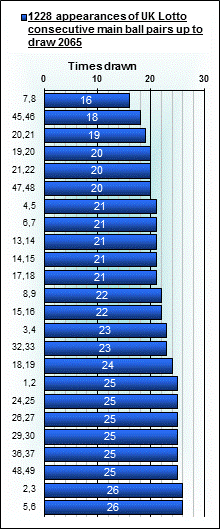 |
 |
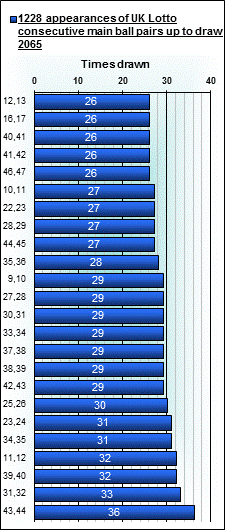 |
This shows how historically since the Lotto began, half of the consecutives have been missing for less than 60 draws, but some extremely long absences pushes the average up to 73.79 draws.
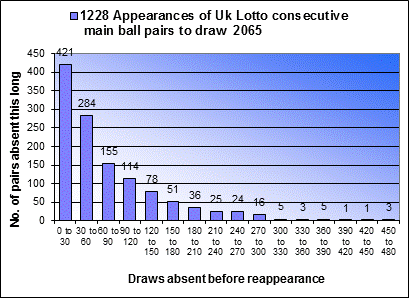
If you look at ALL the 1176 pairs, not just consecutives this graph shows, if you look at the tallest bar, you can read off the horizontal axis how many pairs have the maximum number of appearances..
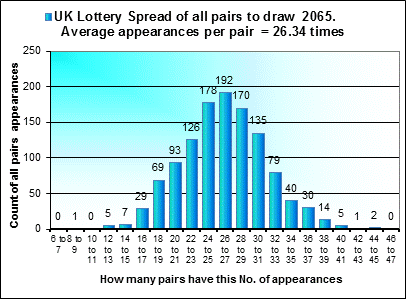
However looking at just the 48 doublets, here is the equivalent chart, similar shape but less total balls.
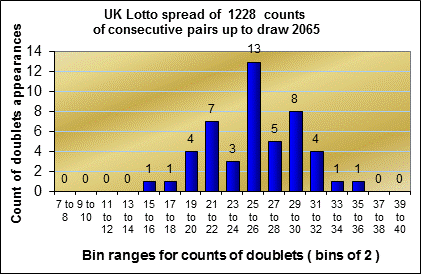
|
|





